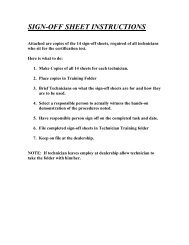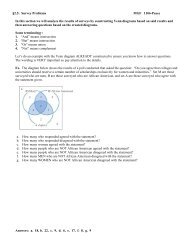MAC 1105 Unit 3 Practice Test Please note that the real test will be ...
MAC 1105 Unit 3 Practice Test Please note that the real test will be ...
MAC 1105 Unit 3 Practice Test Please note that the real test will be ...
- No tags were found...
Create successful ePaper yourself
Turn your PDF publications into a flip-book with our unique Google optimized e-Paper software.
A) B)<br />
C) D)<br />
Answer: A<br />
4) f(x) = x2 + 6x + 5<br />
4)<br />
2
C) D)<br />
Answer: C<br />
12) f(x) = (x + 2)(x + 3)(x + 4)2<br />
12)<br />
A) B)<br />
5
Write <strong>the</strong> equation of a polynomial function with <strong>the</strong> given characteristics. Use a leading coefficient of 1 or -1 and make<br />
<strong>the</strong> degree of <strong>the</strong> function as small as possible.<br />
16) Crosses <strong>the</strong> x-axis at -4, 0, and 1; lies above <strong>the</strong> x-axis <strong>be</strong>tween -4 and 0; lies <strong>be</strong>low <strong>the</strong> x-axis 16)<br />
<strong>be</strong>tween 0 and 1.<br />
A) f(x) = x3- 3x2 - 4x B) f(x) = -x3 - 3x2 + 4x<br />
C) f(x) = - x3+ 3x2 + 4x D) f(x) = x3+ 3x2 - 4x<br />
Answer: D<br />
Find <strong>the</strong> x-intercepts of <strong>the</strong> polynomial function. State whe<strong>the</strong>r <strong>the</strong> graph crosses <strong>the</strong> x-axis, or touches <strong>the</strong> x-axis and<br />
turns around, at each intercept.<br />
17) f(x) = x3 + 10x2 + 33x + 36<br />
17)<br />
A) -3, touches <strong>the</strong> x-axis and turns around;<br />
-4, crosses <strong>the</strong> x-axis.<br />
C) 3, crosses <strong>the</strong> x-axis;<br />
-3, crosses <strong>the</strong> x-axis;<br />
-4, crosses <strong>the</strong> x-axis.<br />
B) 3, crosses <strong>the</strong> x-axis;<br />
-3, touches <strong>the</strong> x-axis and turns around;<br />
-4, crosses <strong>the</strong> x-axis.<br />
D) -3, crosses <strong>the</strong> x-axis;<br />
-4, touches <strong>the</strong> x-axis and turns around<br />
Answer: A<br />
18) x5 - 22x3 + 96x = 0<br />
18)<br />
A) 0, touches <strong>the</strong> x-axis and turns around;<br />
4, crosses <strong>the</strong> x-axis;<br />
-4, crosses <strong>the</strong> x-axis;<br />
6, crosses <strong>the</strong> x-axis;<br />
- 6, crosses <strong>the</strong> x-axis<br />
C) 0, crosses <strong>the</strong> x-axis;<br />
4, crosses <strong>the</strong> x-axis;<br />
-4, crosses <strong>the</strong> x-axis;<br />
6, crosses <strong>the</strong> x-axis;<br />
- 6, crosses <strong>the</strong> x-axis<br />
B) 0, crosses <strong>the</strong> x-axis;<br />
16, touches <strong>the</strong> x-axis and turns around;<br />
6, touches <strong>the</strong> x-axis and turns around<br />
D) 0, touches <strong>the</strong> x-axis and turns around;<br />
16, touches <strong>the</strong> x-axis and turns around;<br />
6, touches <strong>the</strong> x-axis and turns around<br />
Answer: C<br />
7
Solve.<br />
19) The profits (in millions) for a company for 8 years were as follows:<br />
19)<br />
Year, x Profits, P<br />
1993, 1 1.1<br />
1994, 2 1.7<br />
1995, 3 2.0<br />
1996, 4 1.4<br />
1997, 5 1.3<br />
1998, 6 1.5<br />
1999, 7 1.8<br />
2000, 8 2.1<br />
Which of <strong>the</strong> following polynomials is <strong>the</strong> <strong>be</strong>st model for this data?<br />
A) P(x) = 0.03x3 - 0.3x2 + 1.3x + 0.17 B) P(x) = -0.03x4 - 0.3x2 + 1.3x + 0.17<br />
C) P(x) = -0.08x3 + 7x2 + 1.3x - 0.18 D) P(x) = 0.05x2 - 0.8x + 6<br />
Answer: A<br />
Determine <strong>the</strong> maximum possible num<strong>be</strong>r of turning points for <strong>the</strong> graph of <strong>the</strong> function.<br />
20) f(x) = - x2 + 4x + 3<br />
20)<br />
A) 2 B) 0 C) 3 D) 1<br />
Answer: D<br />
Find <strong>the</strong> zeros of <strong>the</strong> polynomial function.<br />
21) f(x) = x3 + x2 - 42x<br />
21)<br />
A) x = 0, x = - 7, x = 6 B) x = 0, x = 5, x = 6<br />
C) x = 5, x = 6 D) x = - 7, x = 6<br />
Answer: A<br />
22) f(x) = x3 - 8x2 + 16x<br />
22)<br />
A) x = 0, x = 4 B) x = 0, x = -4<br />
C) x = 0, x = -4, x = 4 D) x = 1, x = 4<br />
Answer: A<br />
Use <strong>the</strong> Intermediate Value Theorem to determine whe<strong>the</strong>r <strong>the</strong> polynomial function has a <strong>real</strong> zero <strong>be</strong>tween <strong>the</strong> given<br />
integers.<br />
23) f(x) = -3x4 + 3x2 + 5; <strong>be</strong>tween -2 and -1<br />
23)<br />
A) f(-2) = 31 and f(-1) = -5; yes B) f(-2) = 31 and f(-1) = 6; no<br />
C) f(-2) = -31 and f(-1) = -5; no D) f(-2) = -31 and f(-1) = 5; yes<br />
Answer: D<br />
8
Find <strong>the</strong> domain of <strong>the</strong> rational function.<br />
33) h(x) = x + 4<br />
x2 - 36<br />
33)<br />
A) all <strong>real</strong> num<strong>be</strong>rs B) {x|x -6, x 6}<br />
C) {x|x 0, x 36} D) {x|x -6, x 6, x -4}<br />
Answer: B<br />
34) h(x) = 6x<br />
x - 2<br />
34)<br />
A) {x|x 2} B) {x|x -2}<br />
C) all <strong>real</strong> num<strong>be</strong>rs D) {x|x 0}<br />
Answer: A<br />
Graph <strong>the</strong> rational function.<br />
35) f(x) = x 2 + 3x - 10<br />
x2 - 2<br />
35)<br />
A) B)<br />
11
C) D)<br />
Answer: D<br />
36) f(x) = x 2 - x - 6<br />
x2 - 1<br />
36)<br />
A) B)<br />
12
C) D)<br />
Answer: B<br />
Find <strong>the</strong> horizontal asymptote, if any, of <strong>the</strong> graph of <strong>the</strong> rational function.<br />
37) f(x) = 6x<br />
6x + 9<br />
37)<br />
A) y = - 3 2<br />
B) y = 1<br />
C) y = 0 D) no horizontal asymptote<br />
Answer: B<br />
38) f(x) = 10x<br />
5x2 + 1<br />
38)<br />
A) y = 1 2<br />
B) y = 0<br />
C) y = 2 D) no horizontal asymptote<br />
Answer: B<br />
Find <strong>the</strong> slant asymptote, if any, of <strong>the</strong> graph of <strong>the</strong> rational function.<br />
39) g(x) = x 3 + 7<br />
x2 + 8x<br />
39)<br />
A) y = x + 8 B) y = x C) y = x - 8 D) y = x + 7<br />
Answer: C<br />
Graph <strong>the</strong> function.<br />
13
40) f(x) = x 2 - 16<br />
x<br />
40)<br />
A) B)<br />
C) D)<br />
Answer: A<br />
Find <strong>the</strong> vertical asymptotes, if any, of <strong>the</strong> graph of <strong>the</strong> rational function.<br />
41) h(x) = x + 4<br />
x(x - 2)<br />
41)<br />
A) x = 2 B) x = 0 and x = 2<br />
C) x = -4 and x = 2 D) no vertical asymptote<br />
Answer: B<br />
14
42) h(x) = x + 4<br />
x2 - 16<br />
42)<br />
A) x = -4 B) x = 4<br />
C) x = 4, x = -4 D) no vertical asymptote<br />
Answer: C<br />
Solve <strong>the</strong> problem.<br />
43) A company <strong>that</strong> produces computer printers has costs given by <strong>the</strong> function C(x) = 20x + 20,000, 43)<br />
where x is <strong>the</strong> num<strong>be</strong>r of computer printers manufactured and C(x) is measured in dollars. The<br />
average cost to manufacture each computer printer is given by<br />
_<br />
C (x) =<br />
20x + 20,000<br />
.<br />
x<br />
What is <strong>the</strong> horizontal asymptote for <strong>the</strong> function<br />
_<br />
C ? Descri<strong>be</strong> what this means in practical terms.<br />
A) y = 20; $20 is <strong>the</strong> least possible cost for producing each computer printer.<br />
B) y = 20,000; $20,000 is <strong>the</strong> least possible cost for running <strong>the</strong> company.<br />
C) y = 20; 20 is <strong>the</strong> minimum num<strong>be</strong>r of computer printers <strong>the</strong> company can produce.<br />
D) y =20,000; 20,000 is <strong>the</strong> maximum num<strong>be</strong>r of computer printers <strong>the</strong> company can produce.<br />
Answer: A<br />
44) A drug is injected into a patient and <strong>the</strong> concentration of <strong>the</strong> drug is monitored. The drug's<br />
44)<br />
concentration, C(t), in milligrams after t hours is modeled by<br />
6t<br />
C(t) =<br />
2t2 + 1 .<br />
What is <strong>the</strong> horizontal asymptote for this function? Descri<strong>be</strong> what this means in practical terms.<br />
A) y = 3.00; After 3.00 hours, <strong>the</strong> concentration of <strong>the</strong> drug is at its grea<strong>test</strong>.<br />
B) y = 0; 0 is <strong>the</strong> final amount, in milligrams, of <strong>the</strong> drug <strong>that</strong> <strong>will</strong> <strong>be</strong> left in <strong>the</strong> patient's<br />
bloodstream.<br />
C) y = 3.00; 3.00 is <strong>the</strong> final amount, in milligrams, of <strong>the</strong> drug <strong>that</strong> <strong>will</strong> <strong>be</strong> left in <strong>the</strong> patient's<br />
bloodstream.<br />
D) y = 2.00; After 2.00 hours, <strong>the</strong> concentration of <strong>the</strong> drug is at its grea<strong>test</strong>.<br />
Answer: B<br />
Use transformations of f(x) = 1 x or f(x) = 1 x2<br />
to graph <strong>the</strong> rational function.<br />
15
45) f(x) = 1 x - 4 45)<br />
A) B)<br />
C) D)<br />
Answer: A<br />
16
46) f(x) = 1 x2 - 3 46)<br />
A) B)<br />
C) D)<br />
Answer: D<br />
17
Solve <strong>the</strong> polynomial inequality and graph <strong>the</strong> solution set on a num<strong>be</strong>r line. Express <strong>the</strong> solution set in interval<br />
notation.<br />
47) x < 90 - x2<br />
47)<br />
A) (-, 9) (10, )<br />
B) (-10, 9)<br />
C) (-, -10) (9, )<br />
D) (-9, 10)<br />
Answer: B<br />
48) (4x + 1)(2x - 3) > 0<br />
48)<br />
A) -, - 1 4 3 2 , <br />
B) - 1 4 , 3 2<br />
C)<br />
3<br />
2 , <br />
D) - 1 4 , 3 2<br />
Answer: A<br />
18
Solve <strong>the</strong> problem.<br />
49) A ball is thrown vertically upward with an initial velocity of 128 feet per second. The distance in 49)<br />
feet of <strong>the</strong> ball from <strong>the</strong> ground after t seconds is s = 128t - 16t2. For what interval of time is <strong>the</strong> ball<br />
more than 192 above <strong>the</strong> ground?<br />
A) <strong>be</strong>tween 1.5 and 6.5 seconds B) <strong>be</strong>tween 3.5 and 4.5 seconds<br />
C) <strong>be</strong>tween 6 and 10 seconds D) <strong>be</strong>tween 2 and 6 seconds<br />
Answer: D<br />
50) The average cost per unit, y, of producing x units of a product is modeled by y =<br />
650,000 + 0.35x<br />
.<br />
x<br />
Descri<strong>be</strong> <strong>the</strong> company's production level so <strong>that</strong> <strong>the</strong> average cost of producing each unit does not<br />
exceed $6.85.<br />
50)<br />
A) At least 200,000 units B) Not more than 200,000 units<br />
C) At least 100,000 units D) Not more than 100,000 units<br />
Answer: C<br />
Solve <strong>the</strong> rational inequality and graph <strong>the</strong> solution set on a <strong>real</strong> num<strong>be</strong>r line. Express <strong>the</strong> solution set in interval<br />
notation.<br />
51) x + 12<br />
x + 9 < 3 51)<br />
A) (-9, - 15<br />
15<br />
) B) (-, -9) or (-<br />
2 2 , )<br />
C) D) (-, - 15 ) or (9, )<br />
2<br />
Answer: B<br />
19
52)<br />
2<br />
x - 2 < 1 52)<br />
A) (2, 4) B) (-, 2) or (4, )<br />
C) (-, 2] or [4, ) D) (-, 2)<br />
Answer: B<br />
Solve <strong>the</strong> problem.<br />
53) The volume V of a given mass of gas varies directly as <strong>the</strong> temperature T and inversely as <strong>the</strong> 53)<br />
pressure P. A measuring device is calibrated to give V = 210 in3 when T = 280° and P = 20 lb/in2.<br />
What is <strong>the</strong> volume on this device when <strong>the</strong> temperature is 210° and <strong>the</strong> pressure is 25 lb/in2?<br />
A) V = 106 in3 B) V = 126 in3 C) V = 146 in3 D) V = 8.4 in3<br />
Answer: B<br />
Determine <strong>the</strong> constant of variation for <strong>the</strong> stated condition.<br />
54) z varies directly as x and inversely as y, and z = 2 when x = 30 and y = 60.<br />
54)<br />
A) k = 1 2<br />
B) k = 1 4<br />
C) k = 15 D) k = 4<br />
Answer: D<br />
If y varies directly as x, find <strong>the</strong> direct variation equation for <strong>the</strong> situation.<br />
55) y = 4.8 when x = 0.6<br />
55)<br />
A) y = x + 4.2 B) y = 0.125x C) y = 0.6x D) y = 8x<br />
Answer: D<br />
Solve <strong>the</strong> problem.<br />
56) y varies directly as z2 and y = 567 when z = 9. Find y when z = 8.<br />
56)<br />
A) 504 B) 72 C) 448 D) 63<br />
Answer: C<br />
20
Write an equation <strong>that</strong> expresses <strong>the</strong> relationship. Use k as <strong>the</strong> constant of variation.<br />
57) The intensity I of light varies inversely as <strong>the</strong> square of <strong>the</strong> distance D from <strong>the</strong> source. If <strong>the</strong> 57)<br />
intensity of illumination on a screen 40 ft from a light is 3 foot-candles, find <strong>the</strong> intensity on a<br />
screen 50 ft from <strong>the</strong> light.<br />
A) 4.69 foot-candles B) 3.75 foot-candles<br />
C) 1.92 foot-candles D) 2.4 foot-candles<br />
Answer: C<br />
If y varies inversely as x, find <strong>the</strong> inverse variation equation for <strong>the</strong> situation.<br />
58) y = 2 when x = 6<br />
58)<br />
A) y = 12 B) y = x C) y = 1 x<br />
12<br />
3 x D) y = 1<br />
12x<br />
Answer: A<br />
Determine <strong>the</strong> constant of variation for <strong>the</strong> stated condition.<br />
59) t varies jointly as r and s, and t = 52 when r = 26, and s = 8.<br />
59)<br />
A) k = 8 B) k = 1 4<br />
C) k = 4 D) k = 1 8<br />
Answer: B<br />
Solve <strong>the</strong> problem.<br />
60) f varies jointly as q2 and h, and f = 36 when q = 2 and h = 3. Find h when f = 288 and q = 4.<br />
60)<br />
A) h = 2 B) h = 6 C) h = 4 D) h = 3<br />
Answer: B<br />
21








